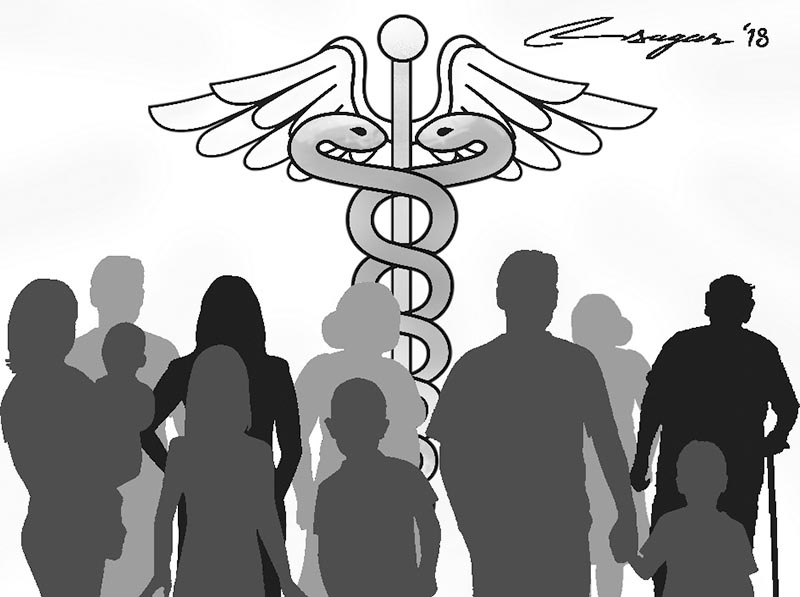Health promotion: Time to adopt new approach
Focusing on individual level for disease prevention is an outdated concept; the new concept of public health, usually called ‘new public health’ or ‘health promotion’, covers a wide range of public health related issues
Health is a fundamental human right. The constitution of Nepal says: Every citizen shall have the right to basic health services from the state; and every citizen shall have equal access to health services. In the mid of 19th century, Dr HA Oldfield, who was a surgeon at the British Residency in Kathmandu between 1850-1863, identified smallpox, malaria, cholera, tuberculosis and problem related to childbirth as major health problems in Nepal. In the last 160 years or so, there has been a sea change in Nepal’s health care services.
Of the four major scopes of health care services — preventive; promotive; curative; and palliative and rehabilitative — focus earlier was more on preventive activities. Nonetheless, all scopes are equally important and play a crucial role in improving overall health of the people. Nepal’s health care services saw drastic improvement after the people’s movement in 1990, which ushered in a new era of multiparty democracy.
Nepal’s first health policy was formulated in 1991, which regulated overall health services, human management and functioning of health staff. Health facilities like health posts, primary health care centres and hospitals engage in diagnosis of diseases and provide medicines mostly based on provisional diagnosis process. Some public health interventions, such as immunisation, nutritional advice, growth monitoring, water purification, open defecation free campaign and iodized salt promotion are successful programmes in Nepal. However, there are many public health issues that still remain to be addressed.
The concept of public health was initiated to control communicable diseases through vaccination and water, environmental and vector control campaigns.
But the public health paradigm is changing day by day and now it has been broadly shifting from just prevention of diseases at individual levels to community health promotion through collaboration and collective efforts.
Between 1978 and 1986, the Ministry of Health worked for public health intervention very effectively to reduce maternal morbidity and mortality, infant and child morbidity and mortality, increase life expectancy and reduce total fertility.
Global health experts realised that primary health care is a must to achieve health for all by 2000. But still we are not sure about whether health is accessible to all.
So, global political and health leaders have agreed on health promotion approach in an advanced way. Under this mission, the Ottawa Charter Declaration in 1986 was adopted in Canada as first Health Promotion International Conference aiming to support primary health care components and principle.
But in Nepal, higher level health policy-makers have failed to translate their words into action when it comes to health concerns, which has put the health promotion issue on the back burner.
There are some key issues that Nepal should focus on to promote public health in the new structure. Many of the public health personnel are yet to internalise the new public health concept. Focusing on individual level for disease prevention is an outdated concept. This was applicable before 1986.
The new concept of public health, usually called “new public health” or “health promotion”, covers a wide range of public health related issues.
Achieving health for all as guaranteed by the constitution of Nepal is possible only through a collective effort.
Nepal Health Sector Support Programme (2016-20) has identified community participation, gender and social inclusion, collaboration and beyond health as the main pillars of public health. In this mission, health promotion for change should be endorsed at micro-, meso- and macro-levels.
Wards, Rural Municipalities, Municipalities as well as provincial and central governments should set up health promotion units, sections, division and departments under the Ministry of Health.
Policy-makers in Nepal also need to clear the confusion about public health and health promotion and identity the scientific difference between them. Public health is the science and art of encouraging health, preventing disease, and prolonging life through the organised efforts of society (Acheson Report, London, 1988).
Public health is a social and political concept aimed at improving health, prolonging life and improving the quality of life among whole populations through health advance, disease prevention and other forms of health intervention.
Health promotion on the other hand is the process of enabling people to increase control over, and to improve their health (Ottawa Charter for Health Promotion. WHO, Geneva, 1986). Health promotion represents a comprehensive social and political process.
So, both are important but the general public health is more about overall prevention of diseases at individual levels where as health promotion focuses more on community improvement through collective effort.
Health promotion is a new public health approach. Health experts should be able to use these two terms effectively, appropriately considering any international practice.
Dhital is doing PhD in Public Health at University of Newcastle, Australia






